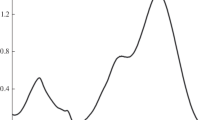Conclusions
-
1.
Molecules of acridine and chloroacridine in the triplet state form triplet exciplexes of the radical ion pair type with tertiary aromatic amines. Proton transfer from the radical cation to the radical anion with formation of neutral radicals is the basic pathway of quenching of these exciplexes in a nonsolvating medium. In the presence of an alcohol, the triplet exciplexes disappear due to protonation of the radical anion in the exciplex.
-
2.
Quenching of triplet states of acridine and chloroacridine by secondary aromatic amines take place by transfer of an H atom from the amine regardless of the nature of the solvent.
-
3.
The singlet excited state is the most probable reactive state of 9-chloroacridine in photoreduction and photosubstitution reactions with aromatic amines.
Similar content being viewed by others
Literature cited
P. P. Levin and V. A. Kuz'min, Usp. Khim.,56, 528 (1987).
P. P. Levin and V. A. Kuz'min, Izv. Akad. Nauk SSSR, Ser. Khim., No. 6, 1250 (1988).
V. Zanker and W. Flugel, Z. Naturforsch.,19B. 376 (1964).
K. Nakamaru, S. Niizuma, and M. Koizumi, Bull. Chem. Soc. Jpn.,44, 1256 (1971).
G. Lodder, in: The Chemistry of Functional Groups, S. Patai and Z. Rappoport (eds.), Supp. D, Wiley, New York (1983), p. 1605.
R. M. Acheson, Acridines, Wiley, New York (1973), p. 117.
J. T. Stewart, T. D. Shaw, and A. B. Ray, Anal. Chem.,41, 360 (1969).
A. Kira, S. Kato, and M. Koizumi, Bull. Chem, Soc. Jpn.,39, 1221 (1966).
N. M. Émanuél', E. T. Denisov, and Z. K. Maizus, Chain Oxidation Reactions of Hydrocarbons in the Liquid Phase [in Russian], Nauka, Moscow (1965), p. 105.
P. P. Levin, T. A. Kokrashvili, and V. A. Kuz'min, Izv. Akad. Nauk SSSR, Ser. Khim., No. 2, 284 (1983).
V. A. Kuz'min, P. P. Levin, and E. V. Rudkovskii, Izv. Akad. Nauk SSSR, Ser. Khim., No. 3, 670 (1987).
T. Shida and A. Kira, Bull. Chem. Soc. Jpn.,42, 1197 (1969).
S. Niizuma, M. Okuda, and M. Koizumi, Bull. Chem. Soc. Jpn.,41, 795 (1968).
Energies of Rupture of Chemical Bonds. Ionization Potentials and Electron Affinities [in Russian], Nauka, Moscow (1974).
K. Kukuchi, K. Kasama, A. Kanemoto, et al., J. Phys. Chem.,89, 868 (1985).
Author information
Authors and Affiliations
Additional information
Translated from Izvestiya Akademii Nauk SSSR, Seriya Khimicheskaya, No. 2, pp. 269–275, February, 1989.
Rights and permissions
About this article
Cite this article
Levin, P.P., Kuz'min, V.A., Fatkulbayanov, R.M. et al. Hydrogen atom transfer and triplet exciplexes in photochemical reactions of acridine and 9-chloroacridine with aromatic amines. Russ Chem Bull 38, 225–231 (1989). https://doi.org/10.1007/BF00953601
Received:
Issue Date:
DOI: https://doi.org/10.1007/BF00953601




